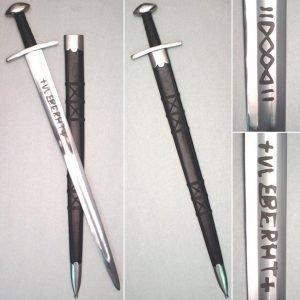
Even before branding was commonplace in marketing, the Ulfberht Sword literally outclassed its competition in battle and through its weight in gold. These swords were among the most sought-after possessions during the period from 800 AD to 1000 AD. The metal of which the sword was comprised was very strong and pure. Each sword was adorned by the Ulfberht name alongside two crosses, giving off a sense of heaven-imbued power.
While it wasn’t quite certain who made the swords, the brand is thought to have originated in Francia (an area also called the Rhineland that is now divided between France and Germany), because of the prominence of its smithing industry at that time, and the relative proximity to the Vikings, the most known wielders of the devastating sword.
Ulfberht swords were stronger, sharper, and more flexible than any other type of swords. They were literally capable of going toe-to-toe with any other sword on the block, and be the last man standing. When the swords clashed, Ulfberht swords tended to break the opposition’s sword mid-combat, leaving the enemy without a weapon and feeling practically useless. It would not shatter when a man used his Ulfberht sword to block, and it was strong enough to cut through even the toughest of chain mail.
Why was the sword so powerful?
It all started with process of creating an Ulfberht Sword. They were literally centuries ahead of their competition, utilizing techniques unbeknownst to smiths even today. When a sword is created, there has to be a proportionate distribution of carbon in the blade to be usable. Too much carbon will render the sword weak and easily broken, while too little will result in a flimsy sword that just bends. Ulfberht Swords distribution of carbon was perfect, which allowed the blade to be sharp and durable. This process is comparable to the ways Arabs produced their famous Damascus steel around the same time.
Where were they produced?
Were the Ulfberht Swords entirely manufactured from zero to hero in Francia? Or was it a marketing genius who thought of “dropshipping” quality steel parts from the Middle East, slapping a brand on that blade, and marking it up to be the “best sword on the market?” Either way, the notoriety and prestige associated with the sword spoke for its reputation, so an origin story would just be icing on the cake.
Branding
The price of the swords was literally an arm and a leg, as not only did it represent a symbol of power, wealth, and status, it was perceived to be better than any other sword. 170 authentic Ulfberht Swords were distributed, and with such a low supply, the costs were quite high. They were branded as a tool only usable by the elite. But with great power comes great responsibility, and each knock-off attempt at an Ulfberht Sword only resulted in devastating repercussions in the battlefield, where it isn’t the sword that determines the fight, it’s the wielder.Swords were the most expensive item that many men owned at this time. It was mark of who the person was, and as the quality rose, so did the difficulty and price of making it. They were also family heirlooms, being passed down from generation to generation of family lineage. An Ulfberht Sword would signify a noble family just by mere possession.
Duds
While the legends involving the mysticism of Ulfberht swords were most commonly heard, there are also stories of “fakes” that tried to piggyback on the fame of the originals. Other high-carbon steel-based blades were created with the aid of Asian traders, due to the availability of crucible steel coming from that continent. Viking smiths at this time did not understand the process of creating the steel, so they were forced to scavenge around for the materials however they could. Some Ulfberht swords did not have the same quality of steel as the premium versions, but they were still good quality by any standard. The bottom of the barrel was then filled with the counterfeit blades created by smiths as an attempt to profit from the Ulfberht “branding.”
Just how mystical are the Ulfberht swords? Despite all the hype surrounding them, the logical conclusion seems to involve a simple shipping process from foreign countries for better resources. These blades were quite easy to distinguish, since in addition to obviously low-quality materials being used to construct them, some actually showed misspellings of the brand name!
 Modern Day Ulfbehrt Sword and Sheath
Modern Day Ulfbehrt Sword and Sheath
This was a very interesting read, thanks for sharing. I had never heard of these kinds of swords before. I have heard of Damascus steel for sure, but never the Ulfberht sword. I think people have always shown a keen sense when it comes to business dealings and the assumption that it was strategic branding is probably correct.
Damascus is on my list to do, but as you said, it is the more commonly known type. I always thought this was more interesting in the branding/marketing sense as well
Glad you enjoyed it